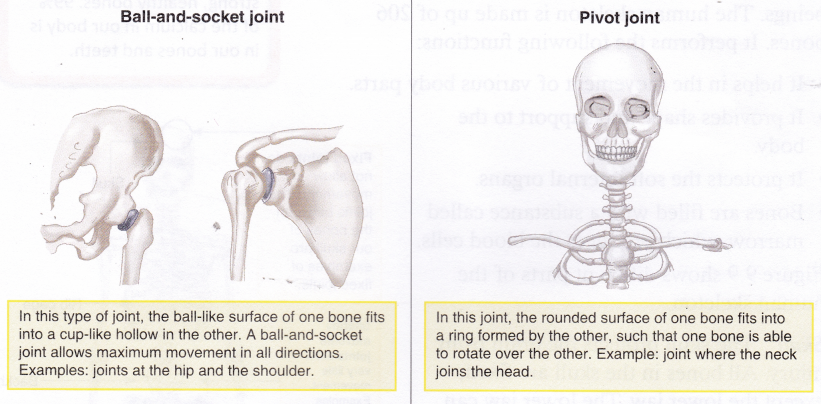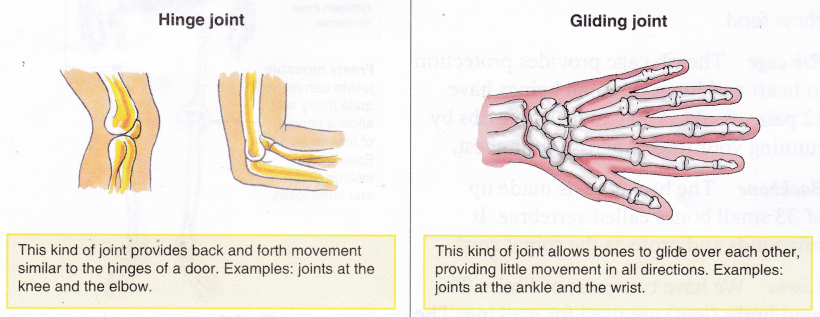Movement In Human Beings
The skeletal system along with the muscular system helps in movement in human beings. The human skeleton is made up of 206 bones. It performs the following functions:
- It helps in the movement of various body parts.
- It provides shape and support to the body.
- It protects the soft internal organs.
- Bones are filled with a substance called marrow, which produces the blood cells.
Figure shows different parts of the human skeleton.

Skull The skull protects the brain from injury. All bones in the skull are fixed, except the lower jaw. The lower jaw can move. Its movement allows us to talk and chew food.
Rib cage The rib cage provides protection to heart and lungs. Human beings have 12 pairs of ribs. You can feel your ribs by running your fingers across your chest.
Backbone The backbone is made up of 33 small bones called vertebrae. It surrounds and protects the spinal cord.
Limbs We have two pairs of limbs. The hind limbs (legs) are used for walking. The forelimbs (arms;) allow us to do a variety of tasks like lifting and using objects.
Fixed joints do not allow any movement. The joints between the bones of our skull are examples of fixed joints. Slightly movable joints allow very little movement. Examples include the joints between most vertebrae. Freely movable joints can move quite freely and allow a variety of movements. Examples include elbow and knee joints.
Bones are rigid structures that cannot bend. Then how are we able to bend elbows and knees? All our movements are brought about by joints and muscles. Joints are places where two or more bones meet.
The adjoining picture shows the three main types of joints present in our body. Fixed or immovable joints, like those of the skull, provide protection. Slightly movable joints provide support. Freely movable joints are the ones that allow us to perform a variety of movements. The four major movable joints in our body are:
- Ball-and-socket joint
- Pivot joint
- Hinge joint
- Gliding joint
Let us learn where these joints are found in our body.


How Bones Move
Muscles bring about movement by contracting (shortening) and relaxing (lengthening). One end of a muscle is attached to a movable bone, whereas the other end is attached to a fixed bone. When the muscle contracts, it pulls the movable bone. Muscles work in pairs.Figure 9.10 shows how a pair of muscles ‘biceps and triceps’ helps you to move your arm. The muscles in your legs work in a similar manner.

Cartilage
The ends of the bones are covered with a tough, elastic tissue called cartilage. Cartilage makes the ends of the bones smooth and reduces friction between the bones during movement. Cartilage is also present in various other parts of our body. You could feel cartilage in the upper part of your ear and in the front part of your nose. These parts are not as hard as bones and can be bent.
X-rays
Sometimes when we get hurt, doctors take an ‘X-ray’ photograph of the injured part to find out if there is any fracture in the bones. The pictures given in Figure 9.11 show X-ray images of different body parts. X rays were discovered by German physicist Wilhelm Conrad Roentgen in 1895. Roentgen discovered these rays accidentally, while working in his laboratory. In various experiments, he found that these rays were able to pass through tissues, but not through bones. Today, X-rays are commonly used in medicine (to diagnose fractures) and scientific research.

